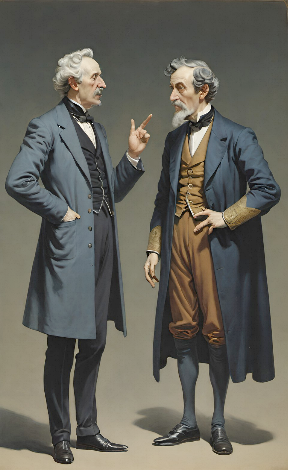The Material – Molecular Body
Recommendation: "The vibrations of the word "Avatar" most accurately correspond to what we mean by a group of subtle bodies, including the physical. Similar to avatars in a computer game, our bodies can also be re-equipped and serve as instruments for interaction with the world. Therefore, the author of the website proposes using this name as a unified perception image for the group of body-suits."
Perception is always clairvoyant. The five sense organs
are merely means of focusing attention.
Avessalom Podvodny, "Selected Aphorisms".
Nature of the Physical Body
Keywords: muscles, bones, skin; movement, anatomy; anatomical features.
We move on to consider the lower body of the dense shell. It is intimately connected with the lower body of the subtle shell, that is, the causal. This connection is expressed, for example, in the fact that it is difficult for us to consider as an event something that does not find its reflection on the physical plane, and a significant part of the efforts of individuals and collectives is devoted to working out ritual symbolism that materializes the causal plane.
The average person, however, practically does not feel their body; more precisely, they feel like they're in an inconvenient spacesuit with a small number of hinged joints: a pair in the feet, a pair in the knees, a pair in the hips; the spine is rigidly fixed in a round bracket position; and the condition of the unfortunate neck is so deplorable that the author suggests anyone interested check it for themselves.
The physical absolute is the source of physical space-time; a hint of it can be caught in modern physical concepts of the vacuum's zero-point energy and its ability to "give birth" to particles. A person connected with the physical absolute can, for example, create various objects from "nothing" (in fairy tales, this ability is symbolized by a self-spreading tablecloth) to the extent that this does not contradict the karma of physical space. However, this requires a very subtle sense of the physical plane at the level of the ability to directly perceive bodies and masses located in all areas of space.
It's surprising how little people see and feel their physical body, and almost don't understand what effect it has on space and those around them. The reason for this, among other things, is the sharp differences between bodies. For example, one can have a coarse and dissolute astral body, but at the same time a quiet, modest, and suppressed physical one. And sometimes it's the other way around. But, as a rule, a person identifies themselves precisely with the astral, thus having a completely distorted idea of the physical.
To understand what this means, imagine you need to draw a portrait of a person in their most typical pose or characteristic movement. In what style would you paint it? What is the most characteristic line: a thin, thick, long, short, straight, oblique stroke; an oval; a triangle; a rectangle... that will appear in all parts of the portrait and its overall contour? What painting or drawing technique would you use: watercolor, gouache, pastel, tempera, oil; pencil, charcoal, pen? What will be the main colors of the portrait and background? People who are used to answering such questions don't necessarily become artists (although, of course, they are artists internally, that is, for their karmic egregore). However, if one cannot answer them, one cannot consider that they satisfactorily see and feel the forms around them and possess spatial culture.
Culture of Movement and Perception of Space
Physical culture usually refers to the art of moving and assuming certain poses — regardless of where a person is. In other words, a dancer, athlete, acrobat, hatha yogi needs a flat surface to demonstrate their skills, and it doesn't really matter what's around it: a forest, concrete walls, or a stadium with spectators. Sometimes additional objects are introduced into the configurational space, but usually of very simple shapes and in small quantities: ribbon, hoop, horizontal bar, maximum parallel bars.
However, human meditation in free space or a space with one simple object is extremely artificial. Man is created for life and movement in a world filled with diverse complex objects, often mobile. And true physical culture primarily means the ability to adapt to the surrounding reality, harmoniously fitting into it.
What does this mean? When a person walks through the forest, they understand that it's better to follow a path than to go straight through bushes, ravines, fallen trees, and windfalls, risking breaking a leg or falling into a pool.
A person who doesn't feel the forest physically perceives their configurational space within it as sharply narrowed: they are afraid to take a step aside; they constantly look around, fearing getting lost; they don't distinguish one clearing from another; and they leave the forest with great relief, as if leaving the walls of a prison. And in a sense, this is exactly what happens. In both cases, their configurational space sharply increases.
Plants and especially animals possess an incomparably richer and more complex configurational space than minerals, so establishing a cultured relationship with them is much more difficult, but if successful, the resulting meditation yields enormous results.
Plant and animal forms are extraordinarily energetic. By interacting with them, a person comprehends both their own body and its hidden possibilities. Where does a child's physical culture begin? At one year old, they learn to walk (and, if lucky with parents, swim) and begin to master rough terrain, climbing trees, and playing with animals. And these activities cannot be replaced by anything. It is precisely these, and not physical strength and "correct" body proportions, that primarily determine a child's physical culture. Can they climb a tree, spend an hour there without getting bored, and return without a single scratch? Do they know how to pick up a dog so that both enjoy it? Can they distinguish a hoopoe from a parrot, and a bunting from a warbler, by voice and appearance, and so on?
Even in such a mundane situation, when a cat enters a room in someone else's apartment where a person is present, one can react in completely different ways. Only a truly physically ill-mannered boor is capable of completely ignoring what happened and behaving as if there is no animal in the room. In any case, the newcomer should be greeted amicably, and one's own configurational space should be somewhat reduced, making room for her.
Next, the cat will perform various maneuvers: for example, she might jump onto the windowsill, arch her back, twitch her tail, meow, run onto the couch, and from there disappear under the table, where she will rustle something and then fall silent for a while. All these movements are accompanied by an avalanche of spatial changes, to which a person should listen and, if possible, correspond. If their body is sufficiently cultured, they will feel the echoes of the cat's movements in the room: suddenly some muscle in their leg will contract and quickly relax, their right hand will slightly twitch, their shoulders will slightly hunch, their lips will slightly twist, the tilt of their head will change, and so on.
If the adaptation to new spatial conditions is successful, after some time a person will experience a feeling of deep comfort in the room with the cat, qualitatively different from their previous existence in a room without a cat. If their paired spatial meditation with the animal becomes especially strong, the cat, instinctively obeying the spatial will, will crawl out from under the table, jump onto the armchair, and settle on their lap for a while, and when the meditation weakens, she will go about her business again. But the room will then take on a completely different appearance for the person, much softer and friendlier. And their configurational space within it will become significantly wider. For example, they will gain permission to approach the sideboard closely and examine its contents through the glass.
Meditation on the Feeling of Space
Sit comfortably in an armchair and relax, but do not close your eyes (if your eyes involuntarily close and deep sleep overcomes you, allow yourself to rest, as freshness is essential for full perception.). Are you truly comfortable? Most likely, your posture is not sufficiently aligned with the furniture arrangement. To eliminate this annoying discrepancy, let's try to merge our body with the room, literally becoming it. To do this, you first need to distribute your limbs and organs among the furnishings, and the easiest way to do this is by geographical principle.
So, you become the room; more precisely, your physical (not etheric!) body comes into alignment with it. In other words, now you don't settle into the armchair, but the room arranges you in it, and it does so piece by piece. Is there a lamp in a lampshade hanging over your head? Excellent. That will be your head, and the fringe your hair. Behind the armchair is a bookshelf. That will be your back, and the books your ribs and vertebrae. You'll feel them immediately, and you'll want to somehow change your back position, or maybe rearrange the books in the shelf or slightly move the shelf itself. To your right, on the shelf, is a record player: the shelf will become your forearm, the record player your hand, the tonearm your thumb, and the stylus needle its nail. Your hand will slightly change its position on the armrest; perhaps your hand will relax a bit and rest more confidently. To your left, on the windowsill, is a vase with flowers—a beautiful ear. Your head will turn slightly, and street sounds will burst into your consciousness: a distant dog bark, children's cries, the clatter of a bulldozer. In front and to the left, the couch with pillows will become your thigh, and the pouf and chair next to it your knee and shin, the rug your foot. At the same time, a peculiar deep sensation will appear in your leg, and it will somehow turn in space, precisely finding its place. In this style, you need to go through all the main objects in the room, correlating them with body parts and internal organs. Your stomach will become the television, your buttocks the armchair you are sitting on, and so on. At some point, you will feel a qualitative change in your well-being. You will stop distinguishing yourself from the room, meaning you will physically merge with it, experiencing an extraordinarily strong, soft comfort and a palpable density of the surrounding space, which will embrace you like the water of a warm bath, but much softer and deeper.
At the same time, difficulties may arise, as you may not always be able to turn as you would like: the limitations of rigid ligaments and the awkward arrangement of furniture, which your body finds difficult to conform to, will play a role. But on the other hand, you will feel where you need to stretch a little and what kind of furniture rearrangement would be desirable.
So, supporting the home as a complex material form is a crucial task. And upon closer inspection, it turns out to be quite subtle. First and foremost, a home lives: the building ages, furniture and household items wear out, gradually being replaced by new ones; finally, family members are born, grow up, and die. Therefore, the configurational space of the home constantly changes, and the arrangement of furniture and household members in the rooms that was convenient a year ago may no longer suit it now. Then a good housewife stops experiencing the usual pleasure during cleaning.
By entering a room and moving through it, a person sharply changes its spatial properties. Possessing an enormous spatial potential as a higher being compared to furniture and walls, a person can crudely, barbarically obliterate all the spatial energy of the room, which it will experience as aggression and humiliation; they can use it for personal purposes, or they can try to delicately fit into the interior, finding the place that the room offers them.
Spatial Behavior
The topic of spatial behavior is closely related to the topic of, so to speak, a person's physical loneliness. Moral loneliness can occur even among friends and in a large family — this is a problem of the Buddhic body, solved by overcoming egoism as a life position and expanding essential consciousness, which includes other people and their lives.
For example, when talking to a person, one needs to be able to find the most suitable places for them and oneself in the room, and first and foremost, to seat them at the correct distance from oneself: not too close, so as to protect their configurational space from oneself, but also not too far, otherwise no palpable spatial meditation will arise.
For example, when, carried away by self-expression, he begins to gesticulate, activates his facial expressions, and literally invades your configurational space, so that you want to move further away, you need to shrink in your size and become a respectful spectator — small, but still distinctly perceptible, so that the partner does not get the impression that you have left entirely and he is indulging in a monologue alone.
Conversely, if you see that your partner is sitting expressionlessly and practically motionless, clearly awaiting your entry onto the spatial stage, you should do so, filling the vacuum between you: smile, make some neat hand gesture in the air, simply sit more comfortably, but do so without oppressing your partner and leaving them the possibility of their own spatial existence and manifestation. But, of course, at the heart of spatial meditation lies similarity: of forms, gestures, and finally, types of spatial existence.
The higher the evolutionary level of an object, the more subtle operations with space it can perform.
Imagine a man you've known for a long time and are on friendly terms with, but nothing more, comes to visit. The usual ritual of your meeting includes a smile and, at most, a light handshake, but today his face expresses unusual joy and he extends his arms to you to embrace you in a tight, obviously masculine hug. You have no time to think, and your physical body acts on its own. Your reaction:
- Immediately jump aside and slap the insolent man.
- Force your way out of the embrace.
- Remain in it, but become completely petrified, crossing your arms over your chest.
- Stand calmly, smiling, with your arms lowered.
- Embrace the man by the shoulders, lean slightly against him, and kiss him on the cheek.
The meaning of the test is as follows: the surrounding men who feel the physical plane do not need to embrace you to understand what your reaction will be, as your body reveals it with every movement, and their bodies perfectly sense its mood and intentions.
Physical sex education begins not when a child is explained the "mystery" of conception and birth. A girl comfortably settled in the fork of a tree will, at a more mature age, be able to sit on the lap of a beloved man without crushing anything, and when he picks her up, she will not feel like a poorly tied sack of potatoes. A boy who knows how to pet a cat and scratch it behind the ear so that it purrs will not, in his youth, grab his girlfriend like a tram handle and drag her to bed like a sheaf of hay.
Sexual organs do not exist separately from the rest of the body, and without its overall cooperation, the sexual act (more correctly, dance) is impossible. However, this dance is led by a paired egregore, and partners must listen to it very carefully. Otherwise, the movements come into conflict with the music, and instead of a waltz, a muddle results.
The coordination of physical bodies necessary for the sexual dance begins at a distance, when future partners simply look at each other a little more attentively and at a slightly closer distance than in ordinary social contact. At this moment, their physical bodies already feel each other well and give unambiguous signals to their owners. In a positive scenario, they might sound, for example, like this: "What a pleasant face this young man has and such a bold smile."
Having learned to be close at a short distance, the partners' bodies, obeying the instructions of the paired egregore, at some point try to move to direct tactile contact, first through clothing, and then with bare skin. And here it is very important to follow not social clichés, especially those offered in erotic films, but the movements of the etheric bodies and the will of the paired egregore as a whole. The sanction for any touch is an etheric meditation so intense that the sensations at the moment of physical contact arise almost the same as during the preceding movement in a dense etheric cloud. The etheric body as a whole comes into a highly excited state. Slow waves begin to move through it, activating simultaneously or in turn the lips, hands, knees, and all other body parts, and indicating to the person the areas of skin ready for sexual touch. They seem to stretch towards the corresponding places of the partner. Gradually, the etheric meditation deepens, and sexual interaction involves not only the skin, but also the subcutaneous fatty tissue, ligaments, and superficial muscles, and then deeper ones, sometimes even internal organs and bones. And accordingly, the nature of physical interactions changes. Light, gentle caresses are replaced by deeply penetrating, but no less gentle compressions, pressures, and so on. At some point, the partners cease to distinguish their bodies. And until this time, it is better not to begin the sexual act in the narrow sense, i.e., an accentuated mutual manipulation of the sexual organs. However, the paired egregore sometimes holds a different opinion, and one should certainly listen to it, and not to the author of these lines.
The natural end of the physical sexual dance is determined by the end of etheric meditation, which occurs when the paired egregore is satisfied with the information-energy exchange that has occurred between the partners (as well as the exchange between themselves and the partners). Sometimes this finale is marked by a joint orgasm of the partners, sometimes of one of them, and sometimes it does not manifest on the physical plane at all, except that the partners suddenly want to move a little away from each other, or stop mutual movements and remain still in peace.
The criterion for the correctness of conducting a sexual act (like any other meditation) is the state and relationship of the partners after it. And, of course, the main thing here is the assessment of the paired egregore: whether it is satisfied or not. And partners usually feel this easily: both directly, and by the new warm thread of mutual trust that arises between them, or, conversely, a wall of cold alienation. For the paired egregore, it is extremely important that physical actions cease immediately upon the completion of etheric meditation, which sometimes, to the bewilderment or even displeasure of the partners, comes to an end much earlier than they intend. That is, strictly speaking, sexual meditation can end at any time, and unsymmetrically for the partners. But if this is provided for by the paired egregore, it will not cause them any (including physical) troubles, which, however, are inevitable if one tries to continue the sexual act without etheric support.
Let's finally free ourselves from dogmas: a woman is not obliged to "climax," a man to "erect." The true source of sexual incompatibility is deep, albeit unconscious, atheism!
The main cause of female diseases is a lack of love for men. The main cause of male impotence is the rigid programming of one's own sexual behavior by the man himself or his partners.
In conclusion, it can be said that the spectrum of movements for which our body is designed is infinitely wide. And it is impossible to predict in advance exactly which sports exercise, pose, or gesture will be required to recreate the vibration necessary for the etheric body today. The natural, universal recipe lies in the constant striving to move in accordance with the spatial energy of the surrounding landscape and the internal needs of the physical and etheric bodies, which, of course, does not exclude one or another health complex, which, however, should not be rigid.







